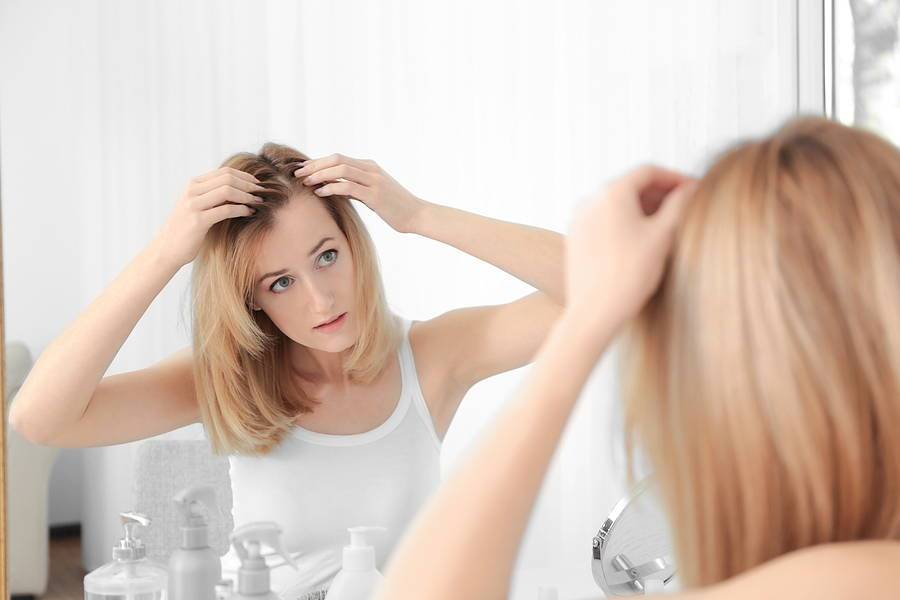Why Can't I Grow My Hair Long?

Why Can’t I Grow My Hair Long?
Does growing your hair feel like watching a kettle that never boils?When you have slow growing hair, every trim is a painful choice between losing the little bit of growth you gained and getting rid of those frizzy split ends to have hair that looks healthy, but shorter than you desire.
So are you doomed to accept your fate? Does some hair just not grow? Why do some ethnic groups seem to have naturally lush, long hair?
Hair Growth Cycle
From the hair on our head to arms and legs, eyelashes, and eyebrows, the hair on our body follows a very specific growth pattern. Our hairs are all in different phases of this growth cycle to ensure that we do not get any bald patches. There are three phases of hair growth known as the:
- Anagen phase
- Catagen phase
- Telogen phase

The Anagen Phase
The anagen phase is the growth phase and the longest phase. Our hair length is determined by the duration of the anagen phase, which can last anywhere between 1 to 10 years. This period is 100% genetically determined, with the average being somewhere between 2 to 6 years.
On the rest of the body the anagen phase lasts:
- 1-6 months on our arms, fingers, and eyelashes
- 5-7 months on our legs
The longer the hair stays in the anagen phase, the longer it will grow. This is why we have very long hairs on our head but shorter hair on the rest of our body.
An individual with a 6-year anagen growth phase (on their scalp) is going to have significantly longer hair than someone with a 2-year anagen phase.
At any time 85 - 90% of our hair follicles are in the anagen phase. Cells are constantly dividing and this new growth is building onto the end of the hair in the follicle, gaining somewhere between 0.3-0.5mm growth per day.
Catagen phase
The catagen phase, or transition phase of the hair, lasts for approximately 1 month and involves 3% of the hair on the head.
Hair growth comes to an end, the hair follicle ceases its activity causing the death of cells in the hair bulb and the retraction of the hair towards the surface of the scalp.
Telogen phase
Fun Fact
For most fur-covered animals, hair growth starts and stops with the seasons. We evolved a telogen phase because furred animals living in cold habitats will find it challenging to find protein-rich foods necessary for new hair shaft production.
How Pregnancy Affects Hair

During pregnancy, many women will experience thicker hair, as higher levels of certain hormones prevent hair loss. Any hairs that have entered the telogen phase will stay on the scalp rather than be shed. The new growth cycle continues for hairs that fell out before pregnancy, which means more hair will remain on the head. After pregnancy when hormone levels normalize, all hairs that would have entered the telogen phase during pregnancy, now begin to shed. This can lead to excessive hair loss called telogen effluvium and it affects 40-50% of women. Within 6 months shedding will begin to normalize and hair will regain its pre-pregnancy volume.
Why do some ethnic groups seem to be able to grow longer hair?
Ethnicity and race play a significant role in determining the length of the anagen, or growth, phase. Studies show that a longer anagen phase is observed in people of Asian descent, those of African descent have the shortest anagen phase, and caucasians are in between. Other factors affecting the duration of the anagen phase include genetics, age, general health, hormonal and nutritional status.
So am I doomed by my genetics?
While, unfortunately, your ethnicity and genetics will play the biggest role in how long your hair can get, there are some things you can do to help get the most out of your anagen phase:
Managing stress and eating a healthy diet
Stress affects your hormones, and this can in turn send a large number of anagen hairs prematurely into the catagen phase. Vitamin deficiencies can also cause less than optimal growth. In the case of iron deficiency, for example, the body compensates for low iron levels in circulation by borrowing ferritin from hair follicles, This reduces the anagen phase, hampering hair growth and causing hair to fall out prematurely.
Many studies have shown that Vitamin D3 deficiency causes hair loss. Vitamin D3 plays a role in the development of new hair follicles and improves hair growth. A Japanese study done in 2012 revealed that Vitamin D3 revives the dormant hair follicles and also creates new follicles. An autoimmune type of hair loss known as Alopecia Areata is linked to Vitamin D3 deficiency. Similarly, other vitamin deficiencies can not only shorten the anagen phase but can also slow the growth because less nourishment is being sent to the hair follicles. Supplementing with vitamins and herbs can not only supply vital nutrients to the follicle but can also stimulate growth and prevent fallout. To learn more about what herbs and vitamins are the most beneficial to hair growth.
Maximizing Blood Flow To The Scalp
Increasing blood flow to the scalp is pivotal for maximizing growth in the anagen phase.
The main hormone that determines the speed of the hair growth cycle, is testosterone (produced by all genders). Genetics determine how sensitive the hair follicles are to testosterone, leading to either a shorter or longer anagen phase. Menthol, found in the mint family of plants, can disrupt testosterone's ability to tell a hair follicle to enter the catagen phase, thereby lengthening the anagen phase. Although you can't cheat genetics, using peppermint oil for scalp massage can help to keep as many hairs retained in the scalp and growing as possible. This is especially useful during times of stress, which affects hormones, and after pregnancy.
Scalp Massage is another method for stimulating circulation in the scalp, allowing more nutrients and oxygen to be delivered to the follicles. Massage your scalp for at least five minutes a day.
How to Massage Your Scalp
Without bending your fingers, start by pushing your whole scalp in a circular motion for 30 seconds. Then move your fingers to a different area, and repeat for another 30 seconds, covering the entire scalp. Next, place your fingers firmly on your scalp and rub vigorously for about 10 seconds. Cover the entire scalp in this way as well. Using coconut oil, castor oil, or a carrier oil mixed with peppermint oil, will provide additional stimulation and nutrients.
Additional Hair Growth Tips
- Do not use rubber bands or metal clips in your hair
- Do not brush wet hair
- Air dry hair whenever possible
- When blow drying, use a negative ion hair dryer and avoid excessive tugging
- Wash hair 3-4 times a week. Over-washing can dry hair out while under-washing can cause build-up which can block hair follicles and lead to hair loss
- Avoid chemical processes such as bleaching, perming, or chemical straightening
- Use natural bamboo brushes
- Rinse with cold water
Protect and strengthen
Finally, if you want to grow your hair or keep it long, you absolutely MUST protect and strengthen your hair. This will help prevent breakage and split ends, allowing you to go longer between haircuts, with less taken off. Lyness Hair Repair Spray contains the following:
- Rhodiola Hair Active, bamboo extract and wheat protein work in synergy to strengthen and invigorate hair, reducing frizz, protecting from damage and making it look healthy, shiny, and stronger.
- Provitamin B5 penetrates readily into skin & hair, moisturizing and softening it, reducing split ends, and adding shine.
- Keratin revitalizes the hair's natural protective layer, protects from harsh chemicals, rebuilds tensile strength, returns elasticity, and reduces breakage.
- Rice Quat is an excellent conditioner, imparting superior wet and dry comb properties. It is well absorbed by damaged ends of the hair, adding strength and moisture
- Silk protein adds luster and shine, body and manageability to hair
Lyness Hair Repair Spray has anti-frizz properties and helps fight against the damage caused by photo-aging and other factors. Use after washing and prior to blow-drying. On non-shampooing days you can use Lyness Hair Repair to spritz hair prior to styling to improve manageability and add shine.
Fun Fact
The average hair can grow to a maximum length of 1 - 1.5m. The longest recorded hair belongs to a Chinese woman, Xie Qiuping, whose hair was 5.627m in length! That’s 562.7cm or 18’46”!





Comments